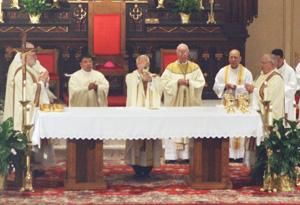
By Deacon Frank Agnoli
(Editor’s note: The publication of the third edition of the Roman Missal provides a great opportunity for each diocese, parish and individual Catholic to grow in their love for — and knowledge of — the liturgy. In this series Deacon Frank Agnoli, the Davenport Diocese’s director of liturgy, reflects on the parts of the Mass.)
The Communion Rite (Part 2)
Posture
As Catholics, we pray with our bodies — and what we do with our bodies affects how we pray. So there are times during Mass when we sit, a posture of relaxed attention. There are times when we stand, a posture of heightened attention and respect. There are times when we kneel, which can be a posture of penitence or a posture of adoration.
In the United States, it has become the familiar practice to kneel after the Lamb of God (for the invitation to Communion) and remain kneeling through the rest of the Communion Rite except when making one’s way to and receiving Communion. Parishes can choose to keep doing things that way. However, there is another option which is common in the rest of the world: to remain standing until all have received Communion.
Bishop Martin Amos, in encouraging this option, recognizes that standing better reflects what it is that we are doing at this point in the Mass. As our diocesan policy explains:
Communion is an act of the assembly together; therefore, to have those in their places, those in the Communion procession, and the clergy adopting the same posture both expresses and helps to bring about our oneness in Christ. In addition, standing facilitates the participation of the assembly in singing, which also serves to foster our unity.
Communion is something that we do together; ought not our body language express that reality?
Invitation
The priest invites us to Communion with these words:
Behold the Lamb of God, behold him who takes away the sins of the world.
Blessed are those called to the supper of the Lamb.
And we respond:
Lord, I am not worthy that you should enter under my roof,
but only say the word and my soul shall be healed.
This exchange is filled with references to the Scriptures: the Lamb of God (John), the supper of the Lamb (Revelation), the words of the centurion (Matthew, Mark). More importantly, this exchange reminds us that we are blessed (not just happy) to be called to the Lamb’s Supper — of which the Eucharist is a foretaste. We come because we are invited, not because we are worthy; the Eucharist is not earned or merited, but is pure gift.
Entering the Mystery
Do I realize how “hungry” I am for spiritual food? Do I come to Eucharist with a heart full of gratitude for the gift I am receiving (a gift; nothing that I can ever merit or earn)?
The Ars Celebrandi
Will I use the advent of the new Missal to help my community revisit how our posture reflects our prayer and our unity with the wider Church? Will I explore with our parish leadership the possibility of moving to standing for the Communion Rite (option 1 below)?








